
St Mary's Isle is a partially submerged reef in Douglas Bay on the Isle of Man. Prior to 1832 the rock was the property of the Quane family until John Quane, Attorney General of the Isle of Man, presented the rock to Sir William Hillary, in his capacity as President of the Isle of Man District of the Royal National Lifeboat Institution to build the Tower of Refuge. Since then the custody of St Mary's Isle has been held by each president of the local lifeboat association.

Douglas is the capital city and largest settlement of the Isle of Man, with a population of 26,677 (2021) and an area of 10.5 km2. It is located at the mouth of the River Douglas, and on a sweeping bay of two miles. The River Douglas forms part of the city's harbour and main commercial port.

Castletown is a town in the Isle of Man, geographically within the historical parish of Malew but administered separately. Lying at the south of the island, it was the Manx capital until 1869. The centre of town is dominated by Castle Rushen, a well-preserved medieval castle, originally built for a Viking king.

The Cathedral Church of Saint German or Peel Cathedral, renamed Cathedral Isle of Man, is located in Peel, Isle of Man. The cathedral is also one of the parish churches in the parish of the West Coast, which includes the town of Peel. Built in 1879–84, it was made the cathedral by Act of Tynwald in 1980.
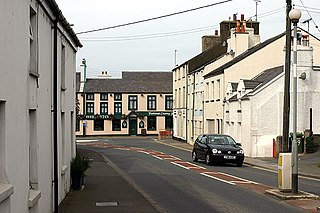
Ballasalla is a village in the parish of Malew in the south-east of the Isle of Man. The village is situated close to the Isle of Man Airport and 2 miles (3 km) north-east of the town of Castletown.

The Tower of Refuge from Shipwreck, referred to as the Tower of Refuge, is a stone-built castellated structure which was erected on St Mary's Isle in Douglas Bay, Isle of Man, in order to afford shelter to mariners wrecked on the rock. The tower was constructed through the endeavours of Sir William Hillary, who had been instrumental in several rescues of sailors stranded on the rock, and which culminated in the heroic rescue of the crew of the Saint George Steam Packet Company steamer RMS St George, when it foundered on the rock in the early hours of 20 November 1830. Sir William personally contributed a high proportion of the costs and secured a substantial number of public contributions for funding the structure.

St. Paul's Chapel is a chapel building of Trinity Church, an episcopal parish, located at 209 Broadway, between Fulton Street and Vesey Street, in Lower Manhattan, New York City. Built in 1766, it is the oldest surviving church building in Manhattan, and one of the nation's finest examples of Late Georgian church architecture.

Sir William Hillary, 1st Baronet was a British militia officer, author and philanthropist, best known as the founder, in 1824, of the Royal National Lifeboat Institution.
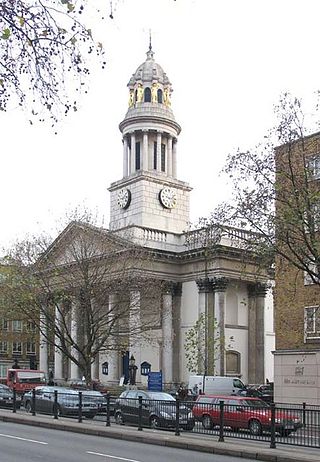
St Marylebone Parish Church is an Anglican church on the Marylebone Road in London. It was built to the designs of Thomas Hardwick in 1813–17. The present site is the third used by the parish for its church. The first was further south, near Oxford Street. The church there was demolished in 1400 and a new one erected further north. This was completely rebuilt in 1740–42, and converted into a chapel-of-ease when Hardwick's church was constructed. The Marylebone area takes its name from the church. Located behind the church is St Marylebone School, a Church of England school for girls.

St Peter's Church is the parish church of Prestbury, Cheshire, England. It is probably the fourth church on the site. The third, the Norman Chapel, stands in the churchyard. The church is recorded in the National Heritage List for England as a designated Grade I listed building. The Norman Chapel, the lychgate and west wall, the Hearse House, and the sundial in the churchyard are listed at Grade II. It is a Church of England parish church in the diocese of Chester, the archdeaconry of Macclesfield, and the deanery of Macclesfield.

Henry Pepys was the Church of England Bishop of Sodor and Man in 1840–1841 and of Worcester in 1841–1860. He gave generously to the Three Choirs Festival, held in Worcester every third year. His daughter Emily gained fame as a child diarist.
Isaac Barrow was an English clergyman and Bishop, consecutively, of Sodor and Man and St Asaph, and also served as Governor of the Isle of Man. He was the founder of the Bishop Barrow Trust. During his time as Bishop of Sodor and Man and Governor of the Isle of Man, he enacted significant social, political, and ecclesiastical reforms. He is sometimes confused with his more famous namesake and nephew, Isaac Barrow (1630–1677), the mathematician and theologian.

St Dunawd's Church, is in the village of Bangor-on-Dee, Wrexham County Borough, Wales. It is designated by Cadw as a Grade II* listed building. The church is an active Anglican church in the deanery of Dee Valley, the archdeaconry of Wrexham and the diocese of St Asaph.
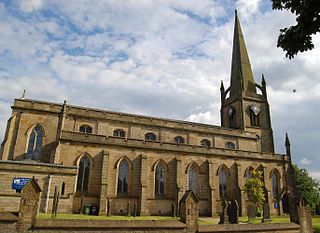
St George's Church is an Anglican parish church serving Tyldesley and Shakerley in Greater Manchester, England. It is part of Leigh deanery in the archdeaconry of Salford and the diocese of Manchester. The church, together with St Stephen's Church, Astley and St John's Church, Mosley Common is part of the united benefice of Astley, Tyldesley and Mosley Common.

St Patrick's Church is a parish church of the Church of England in Jurby parish, near the northwest coast of the Isle of Man. Scotland and Ireland can be seen across the Irish Sea on a moderately clear day. The church also has views down the west coast to Peel, across the northern plain of the island, and to the central hills.
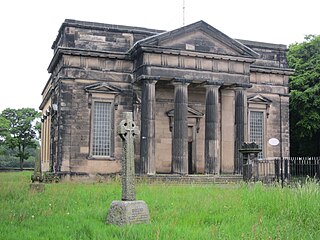
St John's Church is in Liscard Road, Egremont, Merseyside, England. It is a redundant Anglican parish church, formerly in the diocese of Chester. The church is recorded in the National Heritage List for England as a designated Grade II listed building.

The Church of St Mary the Virgin, Aylesbury, is an Anglican church of the Diocese of Oxford, in the centre of the town of Aylesbury. There is evidence of a church from Saxon times, but the present building was built sometime between 1200 and 1250, with various additions and alterations in the 14th, 15th, 19th and 20th century.

The St Mary of the Isle Cathedral, also referred to as the Cathedral of St Mary of the Isle, is a Roman Catholic cathedral in Douglas, Isle of Man. It is part of the Roman Catholic Pastoral Area of St Maughold within the Archdiocese of Liverpool. It is one of two cathedrals on the Island, and one of six Catholic churches. It is referred to locally as St. Mary's. In September 2023, St Mary of the Isle was granted co-cathedral status.

Eleanor (Nelly) Brennan, was a Manx washerwoman who became instrumental in the introduction of the practices of nursing on the Isle of Man. She came to prominence during the cholera outbreaks which affected the town of Douglas in 1832 and 1833 in which she nursed those suffering from the disease. This has led to her becoming known as the "Florence Nightingale of the Isle of Man."
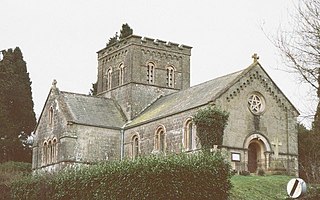
St John's Church is a Church of England parish church in Enmore Green, Dorset, England. The church was designed by George Alexander and built in 1842–43. It is a Grade II listed building.























